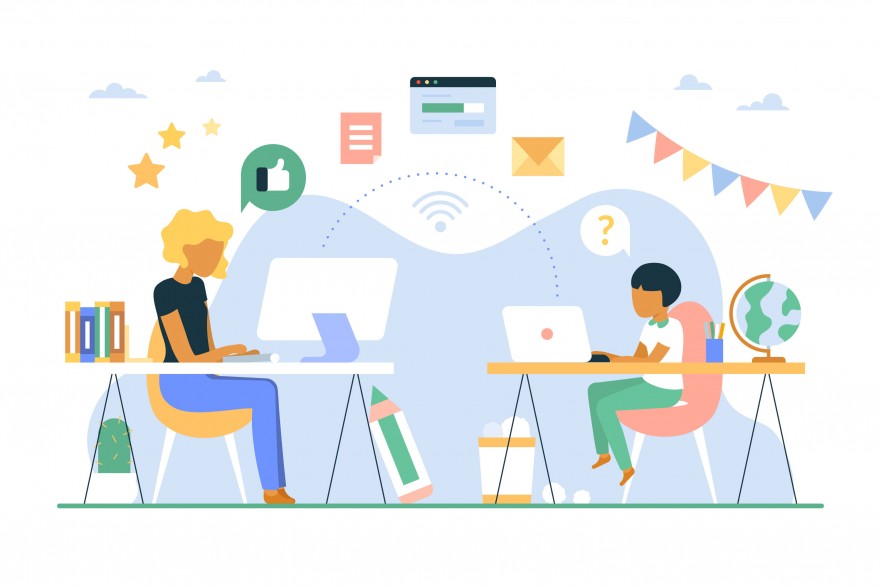You know the feeling. The one when you walk into a classroom where the students and teachers are working together towards a common goal. The room feels warm and inviting. The kids are participating because they trust their teacher and want to work hard for him or her. The teacher is circulating, stopping to ask a probing question or listening to a fruitful conversation among the students. You know true learning is occurring.
What are these fabulous teachers doing, you ask? What’s the magic potion? Classroom Community. They have created a safe space for students to express themselves because they trust their teacher.
I work hard to create a positive classroom community. I start day one with low-risk activities where students get to know each other. We play team-building games and participate in fun non-educational activities before we jump into learning. We consistently are creating our community all year long. It takes time. But it’s 100% worth it.
So when we transitioned to online learning, I was at a loss about how to create the same feeling from my classroom via screens and videos. How could we still connect if we weren’t in the same room?
Could I do it? Or should I just abandon the idea altogether? Was it worth it? I mean, it’s a global pandemic for goodness sakes.
I always like a challenge though. So, I’ve spent the last six weeks trying (and sometimes failing) at providing an online meeting space for students to feel safe, connected, heard, and loved regardless of the location. Here are my takeaways:
- Ice Breakers are easy and worth it! I start every class with a low-risk question. This week I asked my kids, “If you could only eat one food for three meals a day for a week, what would you choose?” Last week I asked, “If you could quarantine with anyone, who would you choose?” I give them think time before calling on every kid in the online meeting. They can pass, but they never do. They want to share. They are craving connection. It’s silly and takes about 5 minutes, but they love hearing each other.
- Presentations allow kids to feel needed and important! In my traditional classroom, my kids present regularly. When we moved online, we didn’t skip a beat. Teams are still creating slides and taking over the class for a few minutes. It’s creating a sense of normalcy and the kids are still working together. They are invested in their teams and the activity.
- When we move into content learning, I start with reflective questions. For example, I ask “What did you like about this poem? Or what didn’t you like about this poem” Then, I wait. Most of the time, a student will unmute themselves (muting was the first skill we learned when we moved online) because they have tons of opinions as most kids do. In a couple of instances where it was awkwardly silent, I called on a student who I believed would feel comfortable sharing. By asking them a low-risk question first, I am creating a safe space for students to share. We don’t move into the deep analysis (or at least some analysis) until they feel comfortable talking about the text and how they felt about it. These conversations have sparked a great conversation that seamlessly led to the analysis.
- Accept when something didn’t work. Last week my principal challenged us to try something new. I heard people talking about an online video website/application where kids can record their responses called Flipgrid. I thought about an activity in my classroom where kids wrote poetry and read it in front of the class last semester. A great activity I thought! Let’s try that online using Flipgrid. The kids will love watching each other read poetry. FAIL! TOTAL FAIL! EPIC FAIL! Only four out of 98 students participated. The kids shared that they don’t like this format. So, it’s back to the drawing board. But that’s okay. I would rather try something and fail than not try at all.
- Games are your friend. My kids loved playing games in our classroom, so I provided this online. We played a free online version of Scattogories. It was so much fun. The kids loved saying, “I have that on my list! Scratch it off.” We also played a Kahoot to review literary terms. Again, they love the competition regardless of where we are.
- Recognize that not all kids will show up at your meeting. We know our students are dealing with a lot right now. They may not be able to attend your meeting. I record every meeting and upload it for kids to watch later. This allows kids to still feel connected even if they can’t attend.
At the end of each meeting, I hope my kids feel good about the time spent with me and their peers. I think many of them are alone the majority of the day and by allowing them to connect, I hope they don’t feel so alone. Classroom community shouldn’t be something that falls to the wayside simply because we meet online. It’s a vital part of the learning process.
How are you creating community in your online learning platforms? Have you tried something that worked? Maybe something that didn’t? Have you tried Flipgrid with success? Please share it below!
Image provided by <a href=”https://www.freepik.com/free-photos-vectors/kids”>Kids vector created by freepik – www.freepik.com</a>










Comments 5
Accepting when something doesn’t work is so hard in a virtual setting. Thank you for the tip to just try and if it fails, move onto something new!
You are right – a classroom community is so important! Creating one online where students feel safe is challenging, so big kudos to you for getting creative and making it work!
I have used FlipGrid with my 3rd grade students, and they prefer to use it to record their thoughts to a story or problem. They love hearing what their classmates think! We used that in class before schools closed for the school year, so it was an easy thing to continue via online learning. I think sometimes they get a little too caught up in adding emojis and silly things like that, but it’s cute to see what they choose to include.
I just heard some teachers share their success with Flipgrid! I got some great ideas! I am glad your kids enjoyed it!
ACCEPTANCE!
It is the last stage of grief, and in my inability to accept some things, I realize that I am very much grieving this missing last quarter.
But also – good on you for trying something new while we’re in this “unknown.” I tried Pear-deck for the first time… I told the kids “i’ve never done this… be patient with me…”
It wasn’t awful, but it also wasn’t great. I was thankful I was experimenting with a group that I had 3 quarters of community with rather than trying it next year with students who don’t know me as well.
It’s always scary to try something new in the classroom, but even scarier online! It was like trying two new things at once!